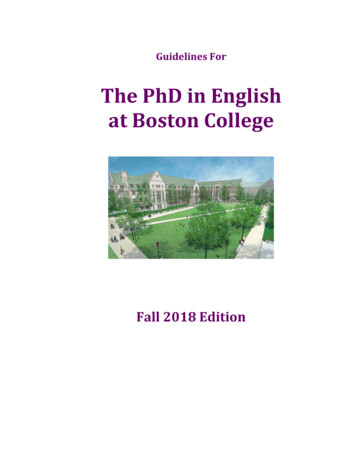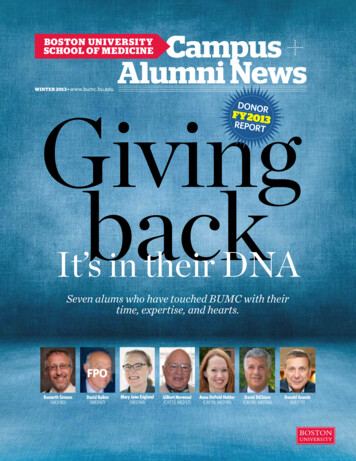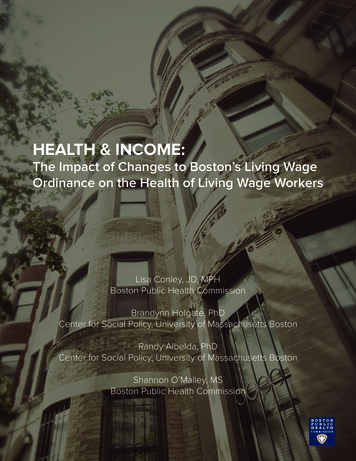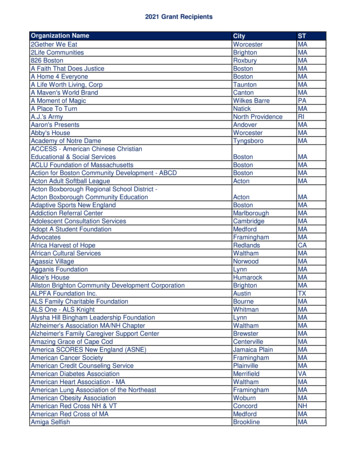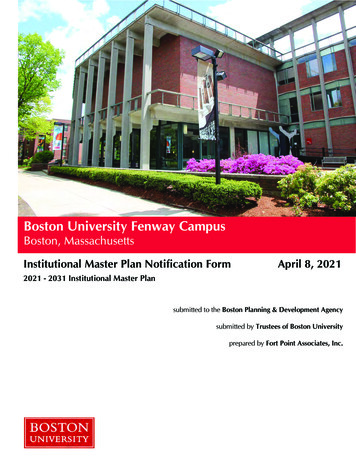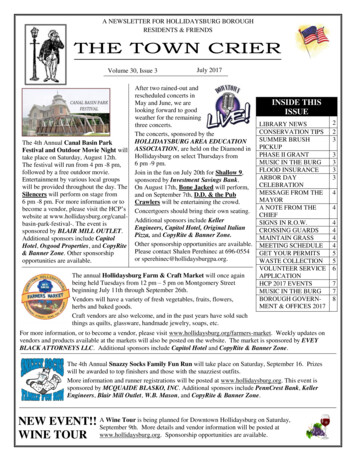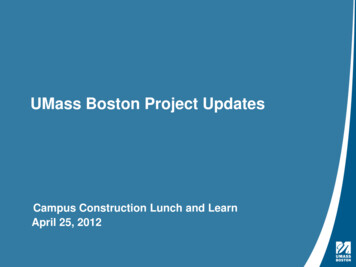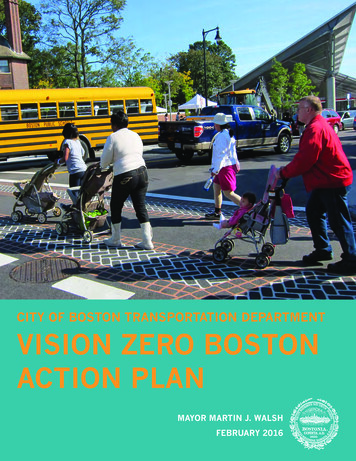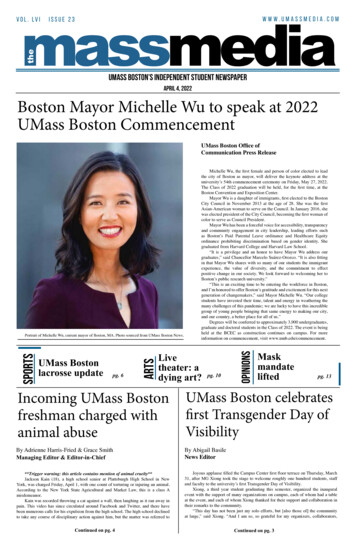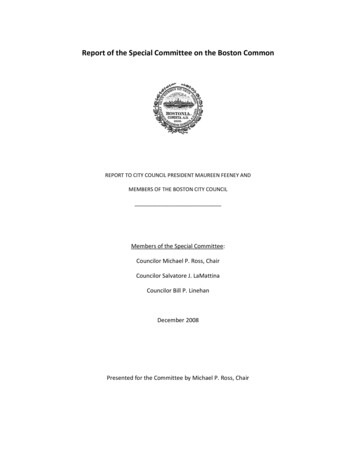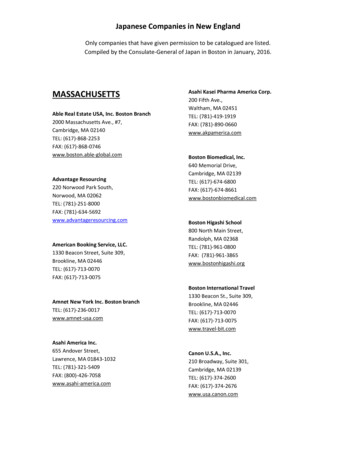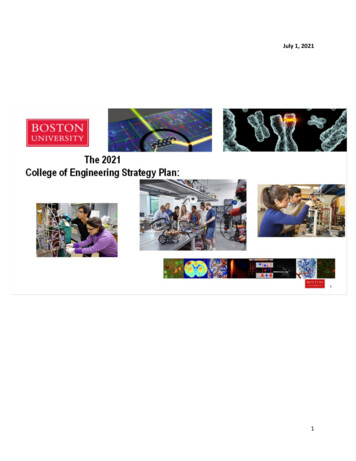
Transcription
July 1, 20211
INTRODUCTION:The College of Engineering at Boston University will embark on an ambitious, unique strategic planbased on a transformational concept for empowering engineering students at all levels to solve complexsocietal problems and faculty to drive high impact research associated with one or more convergentresearch themes. The plan builds on a decade of progress that created a college structure allowing fornimble, flexible thinking across disciplines and a college philosophy for “Creating the Societal Engineer”.The 2021 Strategic Plan intends to create College that is “Engineered for Impact” across all dimensionsof our mission. Our position is that in the future solving complex societal challenges and opportunitieswill require synthesizing methods from traditional disciplines to accelerate the most creative andimplemental solutions. This process is called “convergence” We will create a new kind of engineer andcreate a new kind of faculty community all “Wired for a New World”. Our future engineers and facultywill be driven by and are aware of what is needed to advance quality of life for all members of societyespecially by embracing the power of intersecting and abstracting approaches from multiple disciplinesand from the rich diversity of people that make up society. To this end we propose a unique structurethat retains core disciplines and engineering departments in which faculty lines reside and oversee theeducational curricular for their discipline, while embracing the need to work as a team in order torecruit faculty and students most likely to amplify excellence across a set of six strategic convergentthemes. We propose new operating processes in faculty hiring and mentoring that enhances the powerof collaboration at all stages of their career. We also propose new processes for enhancing ourcurriculum especially in ways that educates students to the importance of diversity for inclusive designand easily allowing student exposure to convergent thinking, for recruiting a new kind of diverse PhDstudents, for seeding high impact ideas in convergent themes, and for partnering with society in generaloutside the academy. In short, our aim is to embrace the concept that “Great minds do not all thinkalike” and intentionally insure we create a community not of like-minded world experts, but openminded diverse world experts each continuously empowering each other. Our Goals are:1. To create a culture and processes capable of leveraging the power or convergence andcollaboration at scale across all aspects of our mission from education to research tosocietal partnerships via corporate and community engagement2. To expand our goal of creating holistic societal engineers across all levels of education thatare empowered with extraordinary problem-solving skills and life-long learning confidence.3. To continuously identify a manageable set of convergent research themes of strength in thecollege that leverage related strengths throughout the College and Boston University andwhich strive to address the most important scientific and technical challenge in society.4. To build strategic and sustainable partnerships with society that stimulate corporateresearch collaborations and our preparing a highly valued workforce with experiences thatprepares them for immediate impact in today’s world.5. To create a community and educational experience that reinforces the extraordinary powerof diversity and inclusion for impacting excellence in education, research and community.This document is complemented by an extensive slide deck that builds the motivation for, concept of,and process of how we will implement our new Strategic Plan, along with an estimate of resourcesneeded for both a “business as usual” budget approach or an aspirational plan that would requiresubstantive new funds to greatly accelerate the plan’s success. Only some slides are also embedded inthe prose of this document. The complete deck is attached with slides referred to by number.2
BACKGROUND:The Unique Structure: A little over a decade ago, the College made a conscious choice to nolonger retain accredited undergraduate BS programs that were not aligned with the preponderance ofthe faculty’s research strength. The result was to terminate our BS programs in Aerospace and inManufacturing Engineering. We restructured to create 3 strong and relatively large departments inwhich all tenure-track faculty lines reside and which supported large and high quality undergraduateand graduate degrees. These were Biomedical Engineering, Electrical and Computer Engineering, andMechanical Engineering. We stood up 2 Interdisciplinary Divisions in which faculty from all threedepartments and cognate ones outside engineering (eg., Chemistry, Physics, Computer Science, etc.)held secondary appointments and contributed to their graduate programs. These were in MaterialsScience and Engineering and in Systems Engineering. The result was a capacity to recruit futureresearch-oriented tenure-track faculty primarily for research goals and needs at the department andCollege levels. Also, this structure was seen as attractive to potential faculty recruits because of thegrowing need and desire of these faculty to interact withfaculty outside their core discipline and to attract Ph.D.students from multiple disciplines.The Societal Engineer (slides 4-6): About adecade ago the College unveiled a strategic plan in whicha guiding philosophy for our educational programs,particularly undergraduates, was “Creating the SocietalEngineer” . We recognized that our mission was notsimply to ensure each student competes courserequirements for a degree and gets an initial placementas an engineer. Indeed, this is necessary of any programin any university, but insufficient. We also recognize that 40% of people getting a BS in Engineering in thecountry are no longer practicing engineers 10-15 yearsafter graduating. We felt our mission was to a) providean excellent engineering foundation in a chosendiscipline with commensurate creative and quantitativeproblem solving skills; and b) provide additionalattributes that complement the degree thatmaximizes the potential for the graduate to haveAlumni feel as though their BU engineering education prepared them for the SocietalEngineer attributes, particularly those that managers find attractivea passion for and a capability for life-long learningand life-long impact on society regardless of whatcareer they eventually pursue. The SocietalEngineer has all the attributes listed in Slide 6.This concept was and remains a powerful one inthe eyes of virtually all relevant stakeholders.When polled, Alumni resonate with it and feelour program prepared them well for mostattributes, particularly the ones that polledpotential employers felt were most valuableSlide #6 in the attached slide deck at the end. 100% 100% 100% 100% 100% 100%47%47%53%53% Global awareness Socialconsciousnessfor products 100%33% A great deal / Very much81%76%76%66%67% Little / Not at all19%24%24% orking in crossWdisciplinary teams Communicationtasks ystemsSlevel thinking34% Innovation andentrepreneurialprocess Alumni that hire and manage teams rankedthese three attributes as most important forindividuals they manage Source: Survey issued 03/25/2020 to College of Engineering alumni who graduated between 2000 and 2019; n 118 Impact ofpublic policieson technologyinnovation andadvancement63
(Slide 6, and bar chart to right). To support a capacity to Create the Societal Engineer we stood upunique educational programs and greatly enhance student experiential opportunities. We created aseries of Concentrations accessible from all BS programs that connect to areas most relevant to society’sfuture ranging from Energy Technologies to our unique Technology Innovation Concentration inpartnership with the Questrom School of Business. Finally, just 3 years ago we introduced the nationsfirst approach to insure and require that every engineering student, regardless of their major, beintroduced to statistical methods with large data (data science) and to machine learning. In short, toprepare them for the digital and big-data driven world that has emerged and impacts virtually allapproaches to technological systems.Rankings (slides 7,8): In 2005 the College was ranked 54th in US News& World report among allEngineering schools. A decade later we were ranked 36th. Most impressive we are now 16th amongengineering schools at private institutions. We are now ranked ahead of many superb engineeringschools such as Case Western, Vanderbilt, RPI, Univ. Rochester, Washington Univ. in St. Louis, Yale, andLehigh all of whom we were ranked below back in 2005. However, given the mathematical way in whichUS News uses metrics to perform the rankings, it will be very difficult for Engineering to move up muchmore. The US News method already is biased to large schools in faculty and student size because it usesfor example total research dollars, total PhD’s graduated, and total enrollments of the master’sprograms and PhD programs combined. We are already over performing on metrics normalized byfaculty size and it will be a challenge to change these dramatically. Two “metrics” that we have no directcontrol over are the reputational survey score from all other Deans and similar from a set of Industriesthat hire our graduates. Survey participants rank other programs between 1-5 with 5 the best.Research Success (Slides 7,8): TheCollege’s research success has beenextraordinary over the past decade. Among thetop 20 ranked Engineering schools at privateinstitutions we rank 10th in extramural researchdollars per faculty member. BostonUniversity’s College of Engineering has about128 tenure-track faculty and 150 total facultywhich places us at the median of the top-20 forprivate institutions. In 2019, compared to theseprograms our faculty brought in the 5th mosttotal dollars (not normalized by size) fromthe NSF and 7th most for funding from theNIH. When one plots the peer surveyreputational score from Deans versusresearch dollars per faculty (slide 8), itbecomes apparent that BU’s reputationalscore is incommensurate with our researchsuccess. Our Dean reputation score hasmoved from 3.0 to 3.2 over the decade butthis rise is not sufficient to place us near anThe College’s Research Success: BU’s R&D expenditures arecompetitive with highly ranked engineering peers10thResearch expenditures per faculty across top-20 private engineering peers, M 1.2 1.2 1.1 0.9 0.9 CalTech MIT USC315Ranking among peers inresearch expenditures perfaculty ( 740K)2021 USNWRXEngineering Ranking 0.9 0.8 0.8 0.8 0.7 0.7 0.7 0.7 0.6 0.6 Johns Columbia UPenn C arnegie Stanford Duke Boston Harvard Cornell N orthHopkinsMellonUniversity western869421316127105th 0.5 0.5 0.5 NYU Vanderbilt Yale171918 North eastern14 0.5Ranking among engineeringpeers in avg. annual NSFgrants ( 8.8M) 0.47th Rice Princeton RPI1511Ranking among engineeringpeers in avg. annual NIHgrants ( 9.2M)20Slide #7 in the Attached slide deck Source: 2021 USNWR Best Engineering School Rankings7BU College of Engineering’s strong comparative R&D expendituresdo not translate into a comparable peer quality perception Bubble size indicates faculty size BU peer set Boston UniversityPeer Assesment Score in US News Ranking, 2021 5.0 MIT Stanford 4.8 4.6 CalTech 4.4 Carnegie Mellon Cornell 4.2 Princeton 4.0 Columbia Northwestern 3.8 Rice 3.6 Yale 3.4 RPI 3.2? Vanderbilt Northeastern 3.0 USC DukeNeed approach that serves to: Boston University NYU 2.8 Johns Hopkins UPenn Harvard Propel our excellence & impact Perceived as an extraordinary differentiator 2.6 2.4 150 450 500 550 600 650 700 750 800 850 900 950 1,000 1,050 1,100 1,150 1,200 R&D expenditures per faculty, kSlide #8 in theAttached slide deck Source: BU data and 2021 US News Rankings84
eye-balled regression line. In fact, if our score had risen to around 3.4 our rankings could improveapproximately another 10-fold.The Challenge: Our college is one of the youngest of all in the top 50 in terms of research-drivengraduate programs. Our first PhD was offered in 1992. Also, unlike most other private institutions, wehave the same faculty size but fewer distinct departments. It is our hypothesis that in order to propelour excellence and impact and in turn our rankings we need to target a process that can rapidly andnoticeably achieve a substantive increase in well-accepted measures of excellence and to become adestination of choice for the most talented and ambitious faculty and students, even if we rank belowother places for them to choose from at that time. The key metrics include ones related to researchfunding and PhD’s produced per year, event-like ones such as landing highly competitive major centergrants (eg., an NSF ERC) or attracting a major philanthropic gift capable of transforming excellence, andfinally actions that are perceived as visionary and important to the future of society in ways otherengineering schools would be envious of and that they perceive as likely to attract more than our fairshare of excellent junior and senior faculty and top PhD students as well as graduate highly desirablestudents at all levels to top-ranked institutions.A UNIQUE and EMPOWERING VISION (Slides 9-13):Society’s Needs (Slide 9):Solutions to society’s grand challengeswill be dependent on breakthroughs intechnology in concert with all otherdimensions of how society functions,from public policy to economic andsocial viability for large scaleimplementation and many others. Slide9 list just a few of the extraordinarycritical challenges we face. Healthcaretechnological breakthroughs haveenormous potential in areas rangingfrom cancer, to gene editing, to chronicSlide #9 in the Attached slide deckdisease, to degenerative brain disorders, and ofcourse to emergent infectious disease. Moreover, the solutions must be deployable at scale and havepotential to lower healthcare costs while improving quality of life. Neurodegenerative diseases impact awide spectrum of our healthcare and community systems. Also, breakthroughs in understanding andmimicking cognition should revolutionize the design of next generation of artificial intelligent systems.Connected and autonomous systems will impact every dimension of our life, from urban function toproduct development, to personalized, predictive and digital medicine. Population growth around citiesalong with aging demographics will require multi-dimensional innovation for urban efficiency andresilience while improving connectivity and productivity from all citizens. The exponential growth in theconnectivity of all dimensions of society including IoT and social media will need breakthroughs incybersecurity, cloud computing, and data science. And of course how will we meet the ever increasingenergy needs in a fashion that does not radically damage earth’s climate causing societal calamity?5
Convergence (Slides 10 - 12): These grand societal challenges cannot be met using the tools of asingle engineering discipline alone nor the discrete application of tools from different disciplines.Indeed, the era of needing to train only single discipline engineers is over. For certain, we still needmany engineers trained deeply in a specific disciplines, but we also need a continuous supply of newkinds of engineers and scientists. We need engineers that bring some expertise to a problem they face,but openly embrace problem solving with people trained in other specific disciplines in order to abstractknowledge, tools and ways of thinking to synthesize new convergent solutions, frameworks andmethods that may likely do not readily emerge from one discipline. This process, called “Convergence”is critical for solving complex challenges in society. Solutions from convergent processes will be morecreative and robust and that likely lead to accelerated success for impacting society broadly and flexibly.They may even lead to brand new (sub)disciplines. Consider the recent field of Synthetic Biology. Theoriginal challenge was how to control intracellular processes to achieve a desired application. Classicalmolecular biologists knew general principals about genetics and the biological molecules that act likesignals to turn genes on or off for eventual protein formation and function These biologist also had toolsthat allowed them to measure if a gene was turned on or a protein was being made. However, theyknew nothing about engineering control and network theory or quantitative modeling of engineeredsystems. Convergence of these fields allowed one to ask if one could literally program a cell to achieve aspecific goal and in a controllable fashion. Thus, was born the field of Synthetic Biology withcommensurate engineered cells. Similarly, the field of biomechanics and mechanical engineering hadalready figured out how to measure mechanical properties of biomolecules, cells, tissues etc. But, withthe discovery that mechanical forces can actually alter the eventual intra and extracellular functions of acell and modulate tissue remodeling, the convergent field of “Mechanobiology” emerged. Similarly,“Intelligent & Autonomous Systems” requires synthesizing approaches from control theory, to AI andMachine Learning, to robotics, to sensors and big data. The list can go on.Government funding agencies have already recognized the potential power of convergentresearch with the NSF calling it out as one of its 10 Big Ideas. But the Academy has not yet figured outhow to transform its structure and processes to practice convergence at scale. In almost everyengineering school the organization and resource allocation and strategy are driven at the departmentallevels where faculty lines reside. This structure inhibits innovation and nimbleness. Interdisciplinaryresearch is practiced in research centers, but these entities typically do not own faculty lines nor theright to stand up degree programs. Also, their directors answer to Deans and Provosts and not theChairs.If one examined the top 20 engineeringschools at private institutions, 18 of them havebetween 5 to 14 departments with 6-14 ABETengineering degree programs (Slide 11). While ourfaculty size is at the median of these 20 institutions( 150 total faculty) we restructured 10 years ago toretain only 3 large departments covering four of thetop six bachelor’s disciplines (Mechanical, Electrical,Computer, and Biomedical) and each having large andvibrant BS, MS and PhD programs plus two crossSlide #11 in the Attached slide deck6
cutting divisions that oversee MS and PhD programs only (Materials and Systems Engineering).THE CONCEPTWe believe that a new operating model can be applied to the College’s nimble structure andBU’s unbounded culture of collaboration resulting in a College Engineered for Impact regarding everydimension of our mission, from relevant cutting edge undergraduate and graduate educationalprograms, pedagogy and experiences based on the most pressing corporate workforce needs, toresearch that matters to society, to partnerships to address society’s challenges and opportunities. Ourgraduates and faculty will Accelerated Creative and Robust Solutions for Complex Societal NeedsBe Wired for a New World requiring engineers that embrace the power of synthesizingacross disciplines to generate new powerful methodsEmbrace the need and advantage of operating in environments Where Great Minds Do NotThink Alike. Rather it is their diversity of expertise and awareness of the power of engagingother experts from disparate fields that maximizes their impact on society.Based on a survey with nearly full participation, nearly 80% of our faculty believe that a strategy drivenby the power and investment in strong existing convergent themes that cut across several departmentsrather one that invests in departments as independent entities is desirable. Moreover nearly 80% feelcollaborating across departments is already strong.Unbounded BU – The College of Engineering 2030 Strategic PlanTHE PLANUnbounded BUThe plan (slide 15) parses into threefundamental pillars. Pillar 1 will enhance theSocietal Engineer at all levels fromIII. Partnering toundergraduate to graduate creatingI. Shaping the SocietalII. Convergent ResearchTransform SocietyEngineer “Wired foracross the College and BU:the New World”graduates that are “Wired for a New- Technology Transfer“Accelerating Impact on- Industry Supported ResearchComplex Societal- Future WorkforceWorld”. Pillar 2 will prioritize investing alongProblems”convergent research themes that cuts acrossIV. Unbounded culture andengineering departments and in which theoperating model to drivecollaboration at scaleCollege already has strength. This is incontrast to the more traditional approach inSlide #15 in the Attached slide deckacademia of investing in individual departments ordisciplines in a decoupled fashion. Pillar 3 will derive a multi-dimensional approach to build sustainableand impactful partnerships with society along three related axes. These include 1) new partnerships toinsure our curricular are modern and experiential thus creating the most valuable workforce for a widerange of industries, 2) creating strategic partners for corporate sponsored research, and 3) translatingour research to benefit society. All three pillars will be supported by a Foundation consisting of uniqueand bold new organizational operating processes and tactics designed to facilitate learning,collaborative research, the power of diversity and inclusion, and partnership at scale and henceaccelerate our impact on society.Organizational strategies and tactics that facilitate learning, collaborative research, diversity& inclusion, and partnership at scale to accelerate unbounded impact on our diverse society715
Pillar 1: Shaping the Societal Engineer (Slide 16-19) Initiatives Reaffirm the key attributes of a Societal Engineer and add the “capacity to abstract acrossdisciplines to develop more creative, robust and impactful problem-solving approaches”Create and sustain cutting edge hands-on facilities for formal educational initiatives andexperiences and for open-innovation by students and insure sustainable resources forsupplies for the large growth instudent projects each year.Educate our undergraduate andgraduate students on howtechnology innovation works from abusiness perspectiveProvide research and corporateexperiences for most of our studentsincluding internship programs at theMS and PhD levelsDevelop programs to help technologyambassadors to increase andbroaden participation in engineering especially among underrepresented groupsSlide #19 in the Attached slide deckInventory/develop a suite of impactful “convergent”technical electives at all levels and develop ways for students to perform crossdepartmental senior capstone projectsIntegrate concepts of diversity and inclusion throughout our curriculum, including the powerof inclusion to enhance product design and success and the negative impact of exclusion.Pillar 2: Advancing Excellence and Impact Along Convergent ThemesThe College of Engineering has developedconsensus that identifies six major convergentresearch themes for which either we are alreadyconsidered best in class or can rapidly become suchand stay as such so long as we derive strategicinvestment and tactics to enhance these themes.Each theme consists of a critical mass of collaborativefaculty from not only all of our engineering programs,but throughout all of Boston University. The themesin alphabetical order are:1)2)3)4)5)6)Energy, Sustainability, & ClimateIntelligent, Autonomous and Secure SystemsMaterials by DesignNeuroengineering and NeurosciencePhotonics and Optical SystemsSynthetic Biology, Tissue Engineering, & MechanobiologySlide #21 in the Attached slide deck8
Each theme results from the combined interests of individual faculty with expertise from a variety ofrelated traditional disciplines and who strive to collaborate to advance powerful new basic and appliedresearch in the convergent theme. For example,consider the theme of Intelligent, Autonomous, andSecure Systems (Slide 22). Faculty in this theme mightbe driven to advance transformative new connectedand autonomous systems to make urban centers moreefficient in function and in energy consumption (e.g.,smart traffic and smart parking) or to develop robust,secure digital and predictive medical systems (e.g.,wearables combined with electronic health records)that result in earlier intervention, better quality of lifeand lower medical costs. Sustained and expandedimpact of this theme requires that we recruit faculty whose baseSlide #22 in the Attached slide deckexpertise spans traditional areas of ECE, Systems Engineering, &Computer Science (e.g., Control Theory, Information Science, Machine Learning and AI, Cybersecurtiy,Cloud Computing, Computer Vision, etc.), of Mechanical Engineering (e.g., Robotics, Dynamic Systems),and Biomedical Engineering (e.g., Biosensing, Bioinformatics). The goal is to create a community offaculty with appointments distributed throughout all these cognate departments but who come to BUnot simply to further enhance their own existing and more narrow expertise, but to collaborate with allthese faculty to pursue the convergent research needed to advance the next societally impactfulintelligent, autonomous and secure systems. Such systems cannot evolve from any one of these facultyworking alone nor from discrete applications of their existing expertise. Instead they must all synthesizetheir expertise to develop robust new systems that best can translate to impact society in a robust way.Slides 22-27 convey the concepts for each ofthe convergent themes. They also show that success inthese themes will require coordination andcollaboration with many departments and schoolsoutside of engineering from the life and physicalsciences in the Collage of Arts and Sciences (e.g.,Physics, Biology, Chemistry, Brain and CognitiveScience, Psychology, Earth & Environmental Science), tothe Medical School, to the Business School (resustainability and digital medicine), to the new Facultyof Computer and Data Sciences, and with many of theSlide #28 in the Attached slide deckuniversity’s research centers and institutes. Most important is that these samethemes resonate with the strategic priority areas for all of Boston University (eg, Life Science andEngineering, Neuroscience, Infectious Disease, Photonics, Computing and Data Sciences,Sustainability) (Slide 28).Convergent Themes vs Individual Departments & Divisions: The above model depends on eachdepartment and division advancing excellence at their levels. Each program will need to identify theirown strategic research themes and priorities hopefully in coordination with the College’s six themes.The program level themes are represented by many of the outer bubble areas in Slides 22-27 and tend9
to capture the areas of excellence and focus at the level of one or more departments. For example aworld-class ECE department could identify optical electronics and photonics, solid state devices,cybersecurity, cloud computing, machine learning and artificial intelligence, sensor networks,communication systems, and computer architecture all as important research foci and strive to hireexcellent faculty among these areas. They would periodically assess new areas or pulling back on olderareas. For example, quantum engineering and computational imaging are rapidly emerging areas. Thekey, however, is that the departments/division continuously convey exciting opportunities to connectthese more discipline specific areas to the College-wide convergent themes. Such faculty would belooking to join an institution that embraces and supports a collaborative culture and enables thesefaculty to not only advance their existing area of expertise but invites them to engage one or moreCollege-wide convergent themes in exciting ways to expand their research impact and aspirations.Similar analogies could be made for all our departments and division. In short, we will necessarily strivefor a co-dependence between the strength and foci of each department and division and the strength,excellence, and foci of the College as a whole.Pillar 3: Partnering with SocietyUltimately research universities impactsociety via their educational and their researchmission. In our case we will partner along threemain axes 1) Technology Transfer from researchperformed by our faculty, 2) Industry SponsoredResearch with companies whose goals align withours and who can establish a relationship thataccelerates applications of our creative researchapplied to products for society, and 3) Future ofWorkforce in which the relationships we develop with companiesalong these convergent themes explicitly andconsistently leads us to innovate and on currentdesign of curricular so that skill sets of our graduatesare most valuable and impactful immediately and inthe long term to societal organizations ranging fromindustry to community to hospitals and so on.Slide #30 in the Attached slide deckRegarding the Future of Workforce, it isknown that academic curricular tend to ossify andthe academy is not perceived as nimble and/orflexible with updating curricular. In short, anSlide #31 in the Attached slide deckengineering BS degree in a specific discipline may not necessarilybe creating the kind of engineers with skills needed most by industry. More than ever, powerful,impactful and foundational methods are evolving that broad sectors of industry need but remaindifficult to find in traditional engineering curricular (consider machine learning or additivemanufacturing or data science). We believe that combining our nimbler program structure with deeprelations with corporation clusters aligned with our convergent themes will result in a more adaptive10
approach for curricular needs for the future. Examples
Source: 2021 USNWR Best Engineering School Rankings X 2021 USNWR Engineering Ranking 3 1 5 8 6 9 4 2 13 16 12 7 10 17 19 18 14 15 11 20 7th Ranking among engineering peers in avg. annual NIH grants ( 9.2M) 5th Ranking among engineering peers in avg. annual NSF grants ( 8.8M) 10th Ranking among peers in research expenditures per faculty ( 740K)
